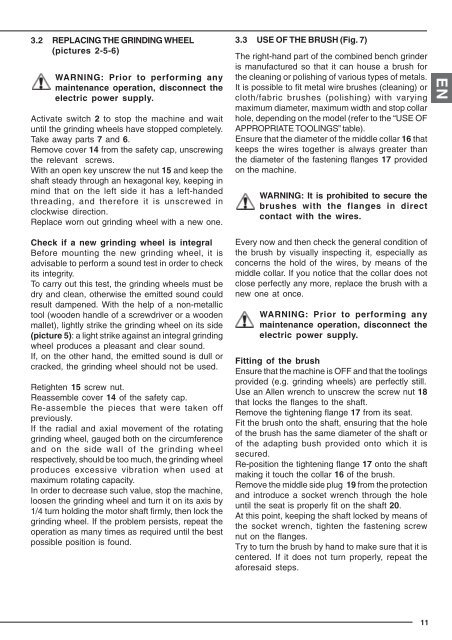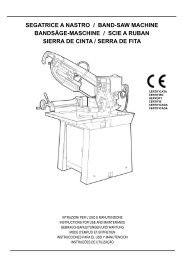istruzioni per l'uso e manutenzione/ricambi instructions ... - Femi S.p.A.
istruzioni per l'uso e manutenzione/ricambi instructions ... - Femi S.p.A.
istruzioni per l'uso e manutenzione/ricambi instructions ... - Femi S.p.A.
Create successful ePaper yourself
Turn your PDF publications into a flip-book with our unique Google optimized e-Paper software.
3.2 REPLACING THE GRINDING WHEEL<br />
(pictures 2-5-6)<br />
WARNING: Prior to <strong>per</strong>forming any<br />
maintenance o<strong>per</strong>ation, disconnect the<br />
electric power supply.<br />
Activate switch 2 to stop the machine and wait<br />
until the grinding wheels have stopped completely.<br />
Take away parts 7 and 6.<br />
Remove cover 14 from the safety cap, unscrewing<br />
the relevant screws.<br />
With an open key unscrew the nut 15 and keep the<br />
shaft steady through an hexagonal key, keeping in<br />
mind that on the left side it has a left-handed<br />
threading, and therefore it is unscrewed in<br />
clockwise direction.<br />
Replace worn out grinding wheel with a new one.<br />
3.3 USE OF THE BRUSH (Fig. 7)<br />
The right-hand part of the combined bench grinder<br />
is manufactured so that it can house a brush for<br />
the cleaning or polishing of various types of metals.<br />
It is possible to fit metal wire brushes (cleaning) or<br />
cloth/fabric brushes (polishing) with varying<br />
maximum diameter, maximum width and stop collar<br />
hole, depending on the model (refer to the “USE OF<br />
APPROPRIATE TOOLINGS” table).<br />
Ensure that the diameter of the middle collar 16 that<br />
keeps the wires together is always greater than<br />
the diameter of the fastening flanges 17 provided<br />
on the machine.<br />
WARNING: It is prohibited to secure the<br />
brushes with the flanges in direct<br />
contact with the wires.<br />
EN<br />
Check if a new grinding wheel is integral<br />
Before mounting the new grinding wheel, it is<br />
advisable to <strong>per</strong>form a sound test in order to check<br />
its integrity.<br />
To carry out this test, the grinding wheels must be<br />
dry and clean, otherwise the emitted sound could<br />
result dampened. With the help of a non-metallic<br />
tool (wooden handle of a screwdriver or a wooden<br />
mallet), lightly strike the grinding wheel on its side<br />
(picture 5): a light strike against an integral grinding<br />
wheel produces a pleasant and clear sound.<br />
If, on the other hand, the emitted sound is dull or<br />
cracked, the grinding wheel should not be used.<br />
Retighten 15 screw nut.<br />
Reassemble cover 14 of the safety cap.<br />
Re-assemble the pieces that were taken off<br />
previously.<br />
If the radial and axial movement of the rotating<br />
grinding wheel, gauged both on the circumference<br />
and on the side wall of the grinding wheel<br />
respectively, should be too much, the grinding wheel<br />
produces excessive vibration when used at<br />
maximum rotating capacity.<br />
In order to decrease such value, stop the machine,<br />
loosen the grinding wheel and turn it on its axis by<br />
1/4 turn holding the motor shaft firmly, then lock the<br />
grinding wheel. If the problem <strong>per</strong>sists, repeat the<br />
o<strong>per</strong>ation as many times as required until the best<br />
possible position is found.<br />
Every now and then check the general condition of<br />
the brush by visually inspecting it, especially as<br />
concerns the hold of the wires, by means of the<br />
middle collar. If you notice that the collar does not<br />
close <strong>per</strong>fectly any more, replace the brush with a<br />
new one at once.<br />
WARNING: Prior to <strong>per</strong>forming any<br />
maintenance o<strong>per</strong>ation, disconnect the<br />
electric power supply.<br />
Fitting of the brush<br />
Ensure that the machine is OFF and that the toolings<br />
provided (e.g. grinding wheels) are <strong>per</strong>fectly still.<br />
Use an Allen wrench to unscrew the screw nut 18<br />
that locks the flanges to the shaft.<br />
Remove the tightening flange 17 from its seat.<br />
Fit the brush onto the shaft, ensuring that the hole<br />
of the brush has the same diameter of the shaft or<br />
of the adapting bush provided onto which it is<br />
secured.<br />
Re-position the tightening flange 17 onto the shaft<br />
making it touch the collar 16 of the brush.<br />
Remove the middle side plug 19 from the protection<br />
and introduce a socket wrench through the hole<br />
until the seat is pro<strong>per</strong>ly fit on the shaft 20.<br />
At this point, keeping the shaft locked by means of<br />
the socket wrench, tighten the fastening screw<br />
nut on the flanges.<br />
Try to turn the brush by hand to make sure that it is<br />
centered. If it does not turn pro<strong>per</strong>ly, repeat the<br />
aforesaid steps.<br />
11




